




Unlocking the social and economic potential of Essex’s communities requires harnessing the power of the area’s cultural and creative industries. This report brings together evidence and insight, highlighting strategic opportunities for the county to drive prosperity and cement Essex’s position as a forward-thinking, culturally rich region.
The UK Government’s sustained and increasing focus on the Creative Industries, exemplified by the 2025 Creative Industries Sector Plan highlights a national appreciation for the immense economic and social benefits of the creative, cultural and heritage sectors.
This national recognition, alongside significant investment in areas like skills development and digital innovation within the sector, presents a clear opportunity for Essex.
By strategically aligning with these national priorities, Essex can attract further investment, tap into national funding streams, and position the county at the forefront of this thriving national agenda.
The Devolution Bill provides an unprecedented opportunity for local regions like Essex to place culture and creativity at the absolute heart of their place-based development strategies. This empowers combined authorities to take greater control over local resources and policy, enabling tailored initiatives that genuinely drive regional economic growth, foster stronger community cohesion, and reduce social exclusion.
For Essex, devolution could mean the potential to unlock specific powers and funding mechanisms to invest directly in unique cultural assets, ensuring that local creative economies are not just supported, but actively accelerated as key drivers of regional prosperity and identity.
on Essex’s
Essex already boasts a dynamic and growing creative and cultural ecosystem, rich in diverse talent, unique venues, and innovative businesses stretching from the digital hubs to traditional crafts and vibrant arts scenes. This report provides the robust evidence base needed for proactive, targeted action.
By strategically investing in and nurturing this sector – for example, through improved infrastructure, targeted skills training, or by fostering greater collaboration between educational institutions and creative businesses – Essex can solidify its position as a key player in the national creative vision. This proactive approach will not only drive significant local economic growth and enhance cultural vibrancy but will also make a direct, tangible contribution to national strategic economic goals, demonstrating Essex’s leadership and capacity for innovation.
This report is structured on a foundation of evidence and insight, which has informed a series of strategic opportunities for the creative sector in Essex.
This report’s findings combine comprehensive data analysis with direct engagement from the creative sector gathered from over 120 members of Essex’s creative communities between May and August 2025.
For a more detailed understanding of the methodology, please refer to the Appendix.
Through an analysis of the evidence and insight, six strategic priorities have been identified to help guide future activities and decision-making.
These provide Culture Essex, Local Authority Partners, Essex’s Cultural Ambassadors, and key stakeholders with a comprehensive guide to strategically grow the creative sector in the region.
Essex has multiple creative hotspots across the county. The highest density of creative jobs and businesses tends to the West of the county, particularly Brentwood, Epping Forest, Chelmsford and Uttlesford. Creative investment has historically been targeted to Chelmsford, Colchester, Southend and to an extent Thurrock.
Essex is home to 6,360 creative businesses, and networks connecting the sector. Partnerships with other businesses were the primary opportunity for creative business growth and development, identified by 54% of survey respondents.
There are around 36,000 creative workers in Essex, of which 22,907 are employed, and 13,365 are freelancers, meaning freelancers make up a third of the workforce. 96% of businesses in Essex are ‘micro-businesses’ with 0-9 employees, even higher than the national average of 93%.
The creative industries in Great Britain contribute nearly 6% to the British economy. However, this research affirmed an existing skills shortage in the industry, and closure of entry routes into creative careers, especially for working class people.
While creative industries in Essex benefit from proximity to London, with highest rates of creative employment seen in West Essex, the service-based nature of many creative industries creates competition, as does specialisation in other regions, for example screen-based industries in West Yorkshire.
Although overall creative jobs in Essex have declined between 2020-2023 (-12.5%), job numbers in film & TV are up by 16.5% and 13.8% in music, performing and visual arts sectors. This shows a strong sub-sector specialisation in the region.
Co-produce a Creative Opportunity Zones pilot programme
Strengthen existing creative clusters as attractive locations for creatives to locate, start-up and grow.
Intensify creative networks through collaboration
Work through existing networks to create opportunities for creatives to collaborate.
Focus support on highpotential sub-sectors
Particularly film and TV, and music, performing and visual arts, which are growing in Essex.
Become a leader in creative freelancer support
Develop relevant support for freelancers, and make systemic changes that support freelancers.
Strengthen the skills and talent pipeline in Essex
Create practical pathways into the industry and opportunities for lifelong learning and creative skills development.
Promote Essex as a creative industries destination
Consider a campaign, investment prospectus, or cultural manifesto.
This study, commissioned by Culture Essex, establishes a vital baseline to formally recognise the cultural and creative industries as significant social and economic contributors within the county.
Strategic investment in this sector will unlock Essex’s full potential, solidifying its position as a key national creative player, driving economic growth, and enhancing cultural vibrancy while contributing to national strategic goals.

Published in 2025, the UK’s Creative Industries Sector Plan aims to make the UK the world’s leading destination for creative investment and innovation by 2035. Its key priorities include boosting investment, innovation, skills, and regional growth.
For Essex, this national focus offers a significant opportunity to align its local strategy, leverage national momentum, and attract essential investment to its burgeoning creative sector.

In direct response to this national strategic shift and the evolving landscape of local governance, Culture Essex is proactively engaging with the dynamic needs of the county’s creative industries. This pivotal effort aligns with government’s recognition of creative industries as vital catalysts for UK economic growth and innovation. Ultimately, this work seeks to clearly define and unlock opportunities for Essex to maximise its creative potential within this new and transformative era.

Sub-Title



Essex boasts a rich and diverse creative and cultural landscape creating fertile ground for artists, designers, and creative businesses, making it a potentially significant contributor to the wider UK creative economy.
As Essex moves towards greater regional autonomy, devolution signals a fundamental shift from national, ‘one-size-fits-all’ cultural policy to a more localised, community-led approach. This empowers Essex to develop place-specific strategies and funding mechanisms, leveraging its unique cultural assets and local talent.
Devolution presents an opportunity to design bespoke initiatives that enhance the county’s distinct cultural fabric. This new autonomy can enable Essex to foster creative clusters, attract targeted investment, and retain local talent, ultimately unlocking significant economic and social value tailored to its unique aspirations.
Geographical Essex comprises t welve local authorit y districts , alongside the neighbouring unitar y authorities of Southendon-Sea Cit y Council and Thurrock Council.
The area is home to 1.9 million residents , with a population that is steadily increasing . The fastest grow th is occurring among those a ged over 65. Additionally, 17% of the population identif y as belonging to a minorit y ethnic group, representing a 60% increase over the past decade.

In 202 2, Essex Count y Council published its Cultural Strateg y, recognising the impor tance of the ar ts , cultural and creative sectors to the social and economic development of the region . The following are benefits that can be unlocked by understanding the needs of the sector and investing in its grow th and sustainabilit y.
Drive economic grow th by generating high-value jobs and at tracting significant investment , with the cultural sector contributing £124 billion in GVA nationally and employing 2 .4 million people nationally* .
Shape vibrant and distinctive places by levera ging cultural investment to increase foot fall, leng then dwell time, boost business confidence, raise land and rental values , and reduce vacancy and turnover— building a unique identit y that at tracts people and businesses to Essex
Streng then social cohesion and communit y well-being by suppor ting targeted cultural programmes that reduce isolation , increase life satisfaction , boost educational at tainment , and lower crime rates .
Foster innovation and catalyse cross-sector collaboration by enabling the creative sector to ser ve as an incubator for new ideas that energise the wider economy
Retain and at tract top talent by establishing clear career pathways that encoura ge skilled professionals to live and work in Essex .
Boost regional expor ts by amplif ying Essex’ s profile nationally, at tracting more tourism , and securing increased investment .
Proactive action will firmly position Essex as a key player in the UK’s creative industries, driving significant economic growth and cultural vibrancy, directly aligned with national strategic goals.
This report’s findings are underpinned by a robust methodology, combining comprehensive data analysis with direct engagement from the creative sector.
Evidence has been synthesised from existing data and strategic reports, alongside valuable input gathered from over 120 members of Essex’s creative communities between May and August 2025.
For a more detailed understanding of the approach and definitions used, please refer to the Appendix.
– Strategic and background documents: A review of key policy and strategy documents, including the Essex Cultural Strategy, Essex Creative Health Report, and the UK Industrial Strategy, provided essential context.
– Data and analysis: Quantitative insights were drawn from multiple sources, notably the Arts Council England Place and Culture Explorer, to establish a data-driven foundation.
– Online survey: An open survey, conducted between 12th May and 22nd June, engaged a broad spectrum of Essex creative communities and received 102 responses.
– Strategic workshops: Three targeted workshops gathered input from over 20 strategic representatives of Essex’s creative industries across multiple sectors, including key insights from Essex Cultural Ambassadors.
– Strategic conversations: 1:1 conversations with up to six strategic stakeholders relating to key priorities in the UK Industrial Strategy, between late July and August .
22,907 jobs in creative industries in 2023
-12.5% jobs in creative industries 2020-23, led by decline in IT services
+16.5% film, TV, video, radio and photography jobs 2020-23 3.6% of all jobs in Greater Essex were the creative industries in 2023, in line with 3.5% England-wide
6,360 businesses registered in creative sectors in 2024
+13.8% music, performing and visual arts jobs 2020-23
Source: UK Business Register and Employment Survey.

A female-founded fashion brand headquartered in Loughton employing 60-80 people and trading globally.

Essex’ only full time producing venue, with an annual £5.5m turnover producing shows that tour UK-wide and beyond.

CAMA provides sustainability and storage services and software for the Film & TV industry in the UK and beyond.

A visual arts organisation and community hub showcasing artworks from internationally recognised and local artists.

An independent games studio nominated for two BAFTA Games Awards in 2024 for work on Disney Illusion Island.

An award winning dance company delivering participatory projects in hospitals and communities.
Greater Essex is home to 6,360 creative businesses spanning nine key sub-sectors.
While the overall breakdown of its largest sub-sectors largely mirrors the national average, there are notable distinctions:
– Design and Fashion, along with Architecture, represent a significantly higher proportion of creative industries locally than nationally
– whereas Publishing, Museums, Galleries, and Libraries account for a significantly lower percentage.

There are around 36,000 creative workers in Greater Essex, of which a third are freelancers.
Micro businesses make up 96% of creative businesses in Essex, even higher than the national average.
Estimated proportion of self-employed and employed creative workers in Essex
96% of businesses are micro businesses
Creative business sizes in Greater Essex and the UK
employed
Greater Essex’s creative workforce is estimated at approximately 36,000 individuals, comprising 22,907 registered creative jobs (2023) and an additional 13,365 self-employed workers (2021). Creative freelancers represent about one-third of this total.
Note: This combined figure is an estimate due to selfemployment statistics being collected independently from employment data.
Sources: Self Employed: ONS, Census 2021. Occupation by selected economic activity status. Creative self-employed: Numbers of self-employed working in Creative Occupations Employed: Business Register & Employment Survey, 2023.
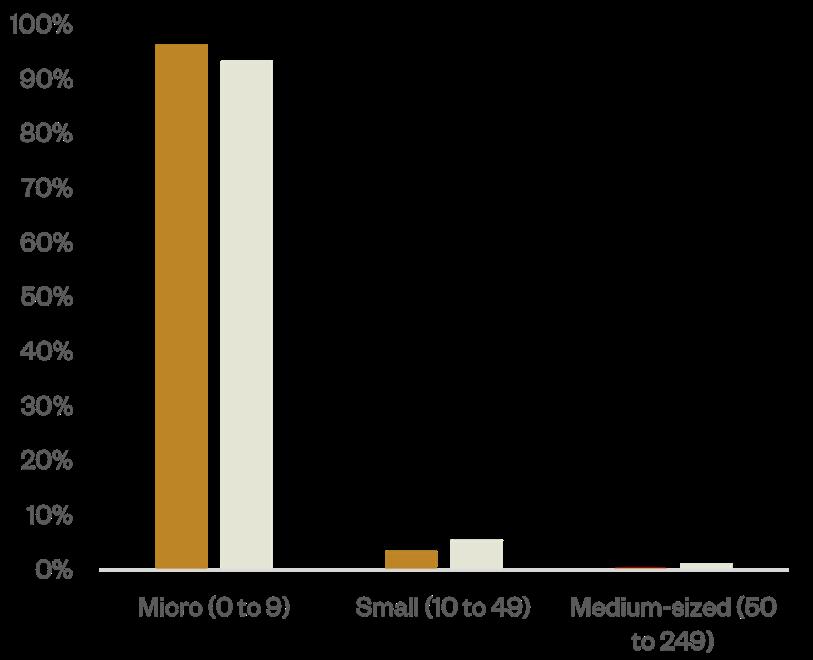
Reflecting national trends, micro-businesses (0-9 employees) dominate Essex’s creative sector, accounting for a notable 96% – even higher than the national average of 93%.
Conversely, small businesses (10-49 employees) represent 3% locally, compared to the national average of 5%. Medium-sized businesses (50-249 employees) are almost non-existent in Essex, at close to 0%, falling slightly below the national average of 1%.
Sources: UK Business Counts - enterprises by industry and employment size band 2024.
The creative sector has been resilient to the challenges faced in recent years, with nationwide job numbers steadily increasing since 2020. This mirrors the national picture.
Creative jobs and business change in Greater Essex, 2020-2024.

Source: UK Business Counts, Business Register & Employment Survey.
Note: Employment count was not available for 2024 at the time this
Survey responses suggest Essex creative industries continue to be resilient, with four out of five (81%) reporting stable or improved performance in the last year.
A combination of better demand and reach to audiences and clients, and innovation, are all key to positive performance.
Survey respondents’ reported performance in the last 12months

Clients, audiences, and innovation are all key to positive performance
Survey respondents’ most common stated reasons for improved performance
– 40% improved demand – 40% introducing new products and services – 35% expanding into new markets – 35% stronger marketing and promotion
A total of 81% of survey respondents reported improved (39%) or stable performance, with only 17% reporting worsened performance.
Source: Essex Creative Sector Survey 2025, Performance n= 102.
There was no single factor driving positive performance, but a combination of improved demand from audiences or clients, being able to expand their offer, better reach clients/ customers, and audiences.
Source: Essex Creative Sector Survey 2025, Reasons for improved performance n= 102.
There has been notable growth in the film, TV, video and photography sectors (+17% jobs), and the music, performing and visual arts sectors (+14% jobs). IT services (-20% jobs) and architecture (-56% jobs) have declined the most significantly in the last 5 years.
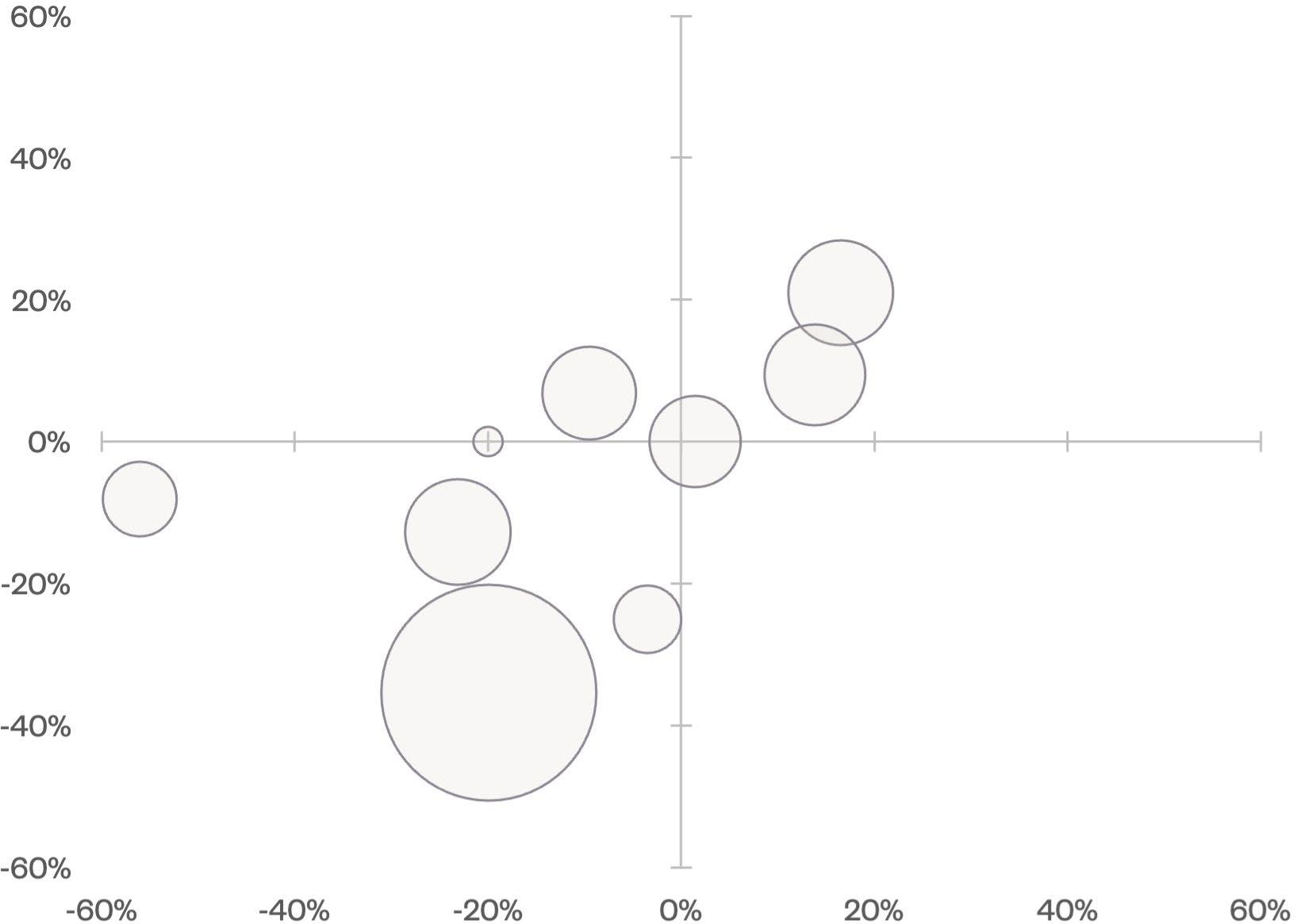
Sub-Title
3.6% of all employees in Essex were employed in the creative industries in 2021, in line with the England where the proportion was 3.5%. Proximity to London tends to relate to higher density of creative jobs, with the exception of Thurrock and Harlow. Further research would be needed to understand the reason for this pattern.
Percentage of all jobs in the borough which are in the

Over the past seven years, Arts Council England (ACE) funding has predominantly been directed towards Colchester and Chelmsford, with Thurrock and Southend also consistently receiving higher investment than other areas in Essex.
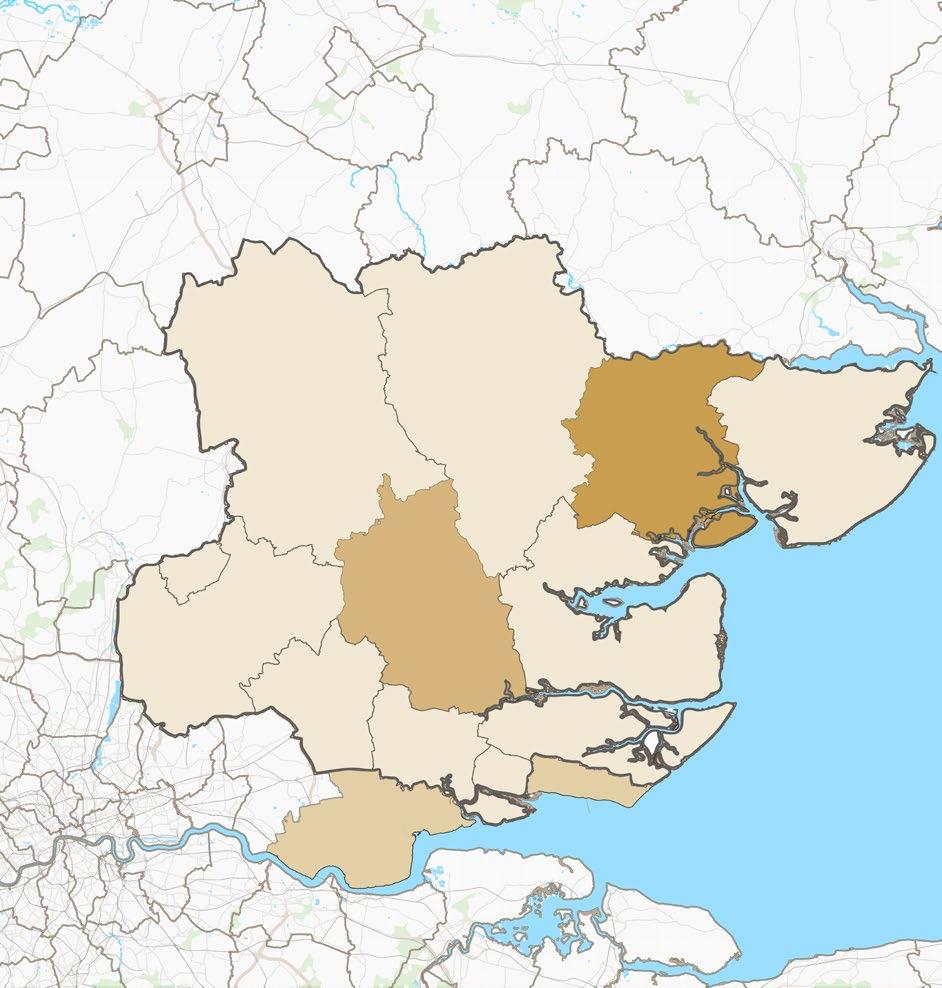
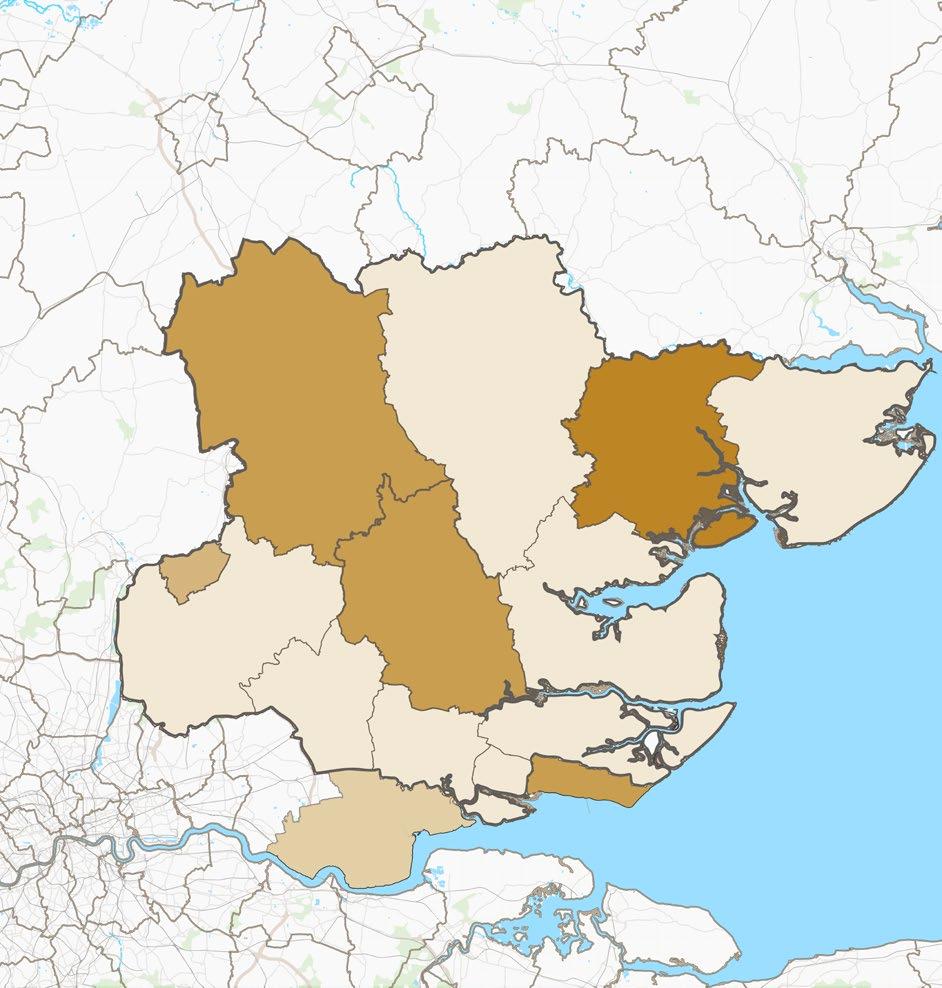
While ACE funding represents only one measure of investment in the creative sector, its distribution patterns broadly align with the existing creative hubs identified in this report. This indicates a concentration of external funding towards established cultural centres within the county.
£5-£9.99
£0 - £4.99
Note that figures are average spending per head. These figures are as reported and are not adjusted for inflation.


Concentration of creative companies is generally higher closer to London, reflecting the positive economic impact of this proximity.
Visitor destinations, and resulting visitor spend is more dispersed, indicating the positive economic impacts and opportunities from Essex cultural and historical hotspots, and coastal areas.

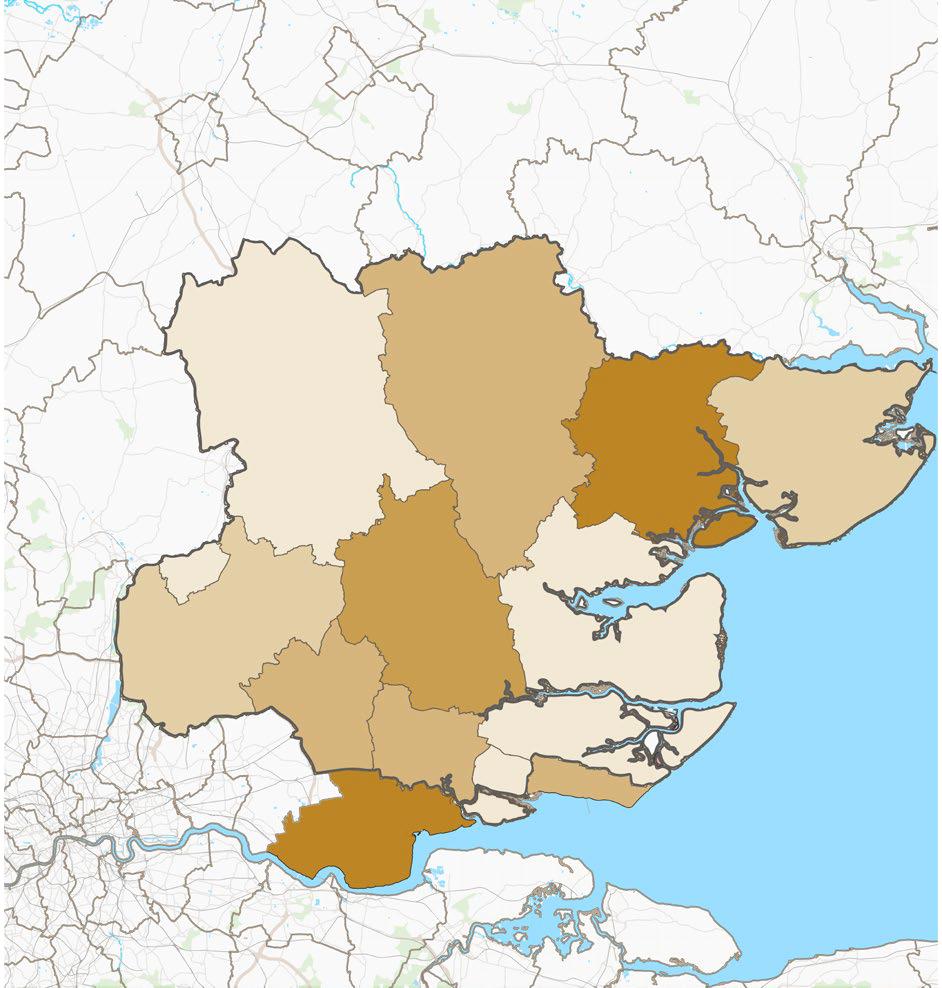
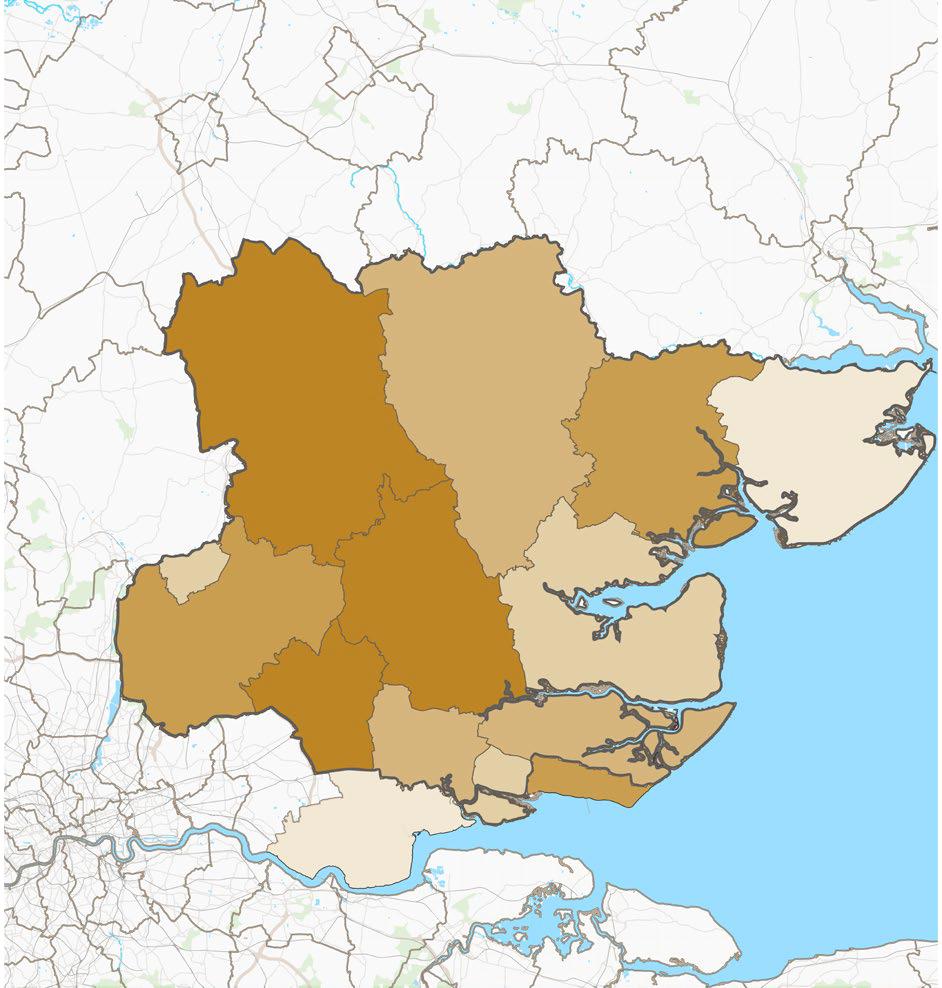

“[Essex is] where I trained and have lived ever since. It’s a large county that is diverse and geographically has many varied landscapes. The people and places are fantastic and draw on this landscape and rich heritage to fuel their work and imagination. Its big, wide skies are particularly part of this charm.”
Multiple sectors, Maldon
“Essex is a unique place to work in the creative industries because it offers a dynamic blend of urban energy and rural inspiration. Its close proximity to London provides access to major clients, networks, and creative opportunities, while maintaining a more affordable cost of living and working. The county is home to a growing number of creative hubs, studios, and co-working spaces. There’s a strong sense of community among local creatives.”
Advertising, marketing, and design sectors, Colchester
“Essex has a thriving creative scene, particularly North Essex where there are numerous self-funded creative activities going on every month. There is a wealth of talent in Essex and very little funding to go around. Essex should absolutely be seen as a creative hub in the UK” .
Multiple sectors, Braintree
“Essex is a large county with a rich heritage. With close proximity to London and Cambridge, we are between two great cultural hubs and benefit greatly from it. We have, and have had, great artists come from the area, or who choose to base themselves here. ... Essex is culturally diverse whilst also being quintessentially British.”
Heritage, Harlow
“Feels like there are multiple creative hotspots instead of just the county town. Limited collaboration though across different parts of the county, compared to other counties we work in.”
Consultancy, Tendring
“Essex is a very underestimated county, especially in north Essex, where the London overspill has, yet to reach, with massive poverty in coastal areas. Surely there is no greater need for artists, storytellers and creatives than in a space where inclusivity is frowned upon daily.”
Music, performing and visual arts, Tendring
81% of respondents reported their organisation’s performance as either improved or stable over the last 12 months, indicating a degree of resilience within the sector.
48% of respondents reported inadequate workspace to fulfil their business potential; additionally, 46% anticipate increasing space needs, with affordable and artist workspace being the most difficult to source.
The most significant barriers identified by creative businesses were the lack of financial assistance (52%) and high operational costs (44%).
Partnerships with other businesses emerged as the primary opportunity for growth and development within the creative sector, highlighted by 54% of respondents.
20% of respondents indicated they had exported goods or services in the last 12 months, highlighting an existing international reach within a segment of Essex’s creative businesses.
Creative businesses most frequently requested support with accessing finance (49%), followed closely by opportunities for networking with other businesses.
Sub-Title
Essex has many strengths, which creative communities feel create a distinct character and identity, despite covering a wide area.
Proximity to London creates opportunity, yet Essex holds its distinctive character, with multiple creative hotspots.
A rich heritage, history and culture, and growing pride in Essex’s creative identity.
Varied landscapes, diverse communities and a range of creative professions
Strong creative networks, and examples of collaboration.
“The cultural clusters (Southend, Chelmsford, Colchester) bring together wide swathes of the cultural sector, making it exciting to collaborate across the sector.”
Music, performing and visual arts, Colchester
“You get proximity to London without the burnout, meaning clients are ambitious but relationships are human. The region’s mix of coastal towns, market villages, and urban centres creates a diverse audience to design for.” Advertising, IT and design, Braintree
Page Title
Sub-Title
Many of the issues affecting creative industries in Essex are experienced nationwide, but local creatives mention that they remain a barrier to growth, and in particular for working class people to access the creative industries.
A ‘brain drain’ of workers to London and increased competition by proximity.
Low earnings, precarity, high running costs, and lack of sustainable funding.
Skills shortage and lack of talent pipeline
A crisis in arts education, and a current skills crisis amplified by Brexit.
Some felt that networks and thinking are not joined up evenly across the area.
Transport infrastructure
Transport challenges like lack of evening bus service restrict workers and audiences.
“Fees have never really recovered from the 2009 crash, and yet costs have rocketed. It’s a challenge to continue year on year to more with less”. Consultancy, Tendring
Sub-Title
Devolution was felt by local creatives to create an opportunity locally to support culture by embedding it in council thinking, and to unlock investment and greater collaboration.
Strengthen Essexwide networks through opportunities to produce culture together, and shared spaces.
Embed culture and creativity
Across the local authorities, prioritising culture, from planning, to health and wellbeing, to local procurement and having a clear ‘front door’ for creative communities.
Facilitating investment by removing barriers, e.g. to filming, or developing land.
“[I need] access to affordable coworking spaces where meeting others in the same industry is possible.” Heritage and music, performing arts sectors, Colchester
“Creatives need more clients. Therefore a campaign on using local suppliers would be beneficial. We have lost out on work to agencies on the south coast.” Advertising and design sectors, Colchester
Page Title
Sub-Title
There are several barriers or threats to growing the creative industries , in the shor t and longer term.
In particular with existing combined authorities like Greater Manchester and West Yorkshire, which have seized the initiative.
Lack of entry-routes into creative careers
A focus on non-creative industries, combined with the closure of local arts courses and institutions, blocks entry routes into the arts.
A ecting the sector’s ability to commit for the long term.
Lack of appropriate spaces and infrastructure Preventing companies from achieving their potential.
“The sector is being revolutionised every year, funding is NOT based on performance, guidance is almost absent.” Music, performing and visual arts, Basildon
“The arts not being nurtured in our young people. Subsidised arts being eroded awayand not valued or invested in.” Multiple sectors, Maldon

Establishing and holding a long term vision for creative Essex that looks beyond short term pressures.

Promoting the vision within Essex to the creative sector and outwardly to workers, investors and government.

Bringing together different partners including local cultural anchors, to deliver the vision for the place.

Using smaller amounts of seed funding as a catalyst, and stable long term funding where possible.

Removing barriers to growth and partnership working, to unlock opportunity.

Bridge-builder
Working crossdepartmentally to embed culture and creativity in delivery priorities.
Co-produce a Creative Opportunity Zones pilot programme
Strengthen existing creative clusters as attractive locations for creatives to locate, start-up and grow.
Intensify creative networks through collaboration
Work through existing networks to create opportunities for creatives to collaborate.
Focus support on highpotential sub-sectors
Particularly film and TV, and music, performing and visual arts, which are growing in Essex.
Become a leader in creative freelancer support
Develop relevant support for freelancers, and make systemic changes that support freelancers.
Strengthen the skills and talent pipeline in Essex
Create practical pathways into the industry and opportunities for lifelong learning and creative skills development.
Promote Essex as a creative industries destination
Consider a campaign, investment prospectus, or cultural manifesto.
The opportunity
Co-produce a pilot programme building on existing clusters, with business support and workspace provision creating an attractive environment for creatives to locate, start-up and grow.
The impact
A critical mass of creative industries in key locations that helps the creative economy to grow and seeds new opportunities.
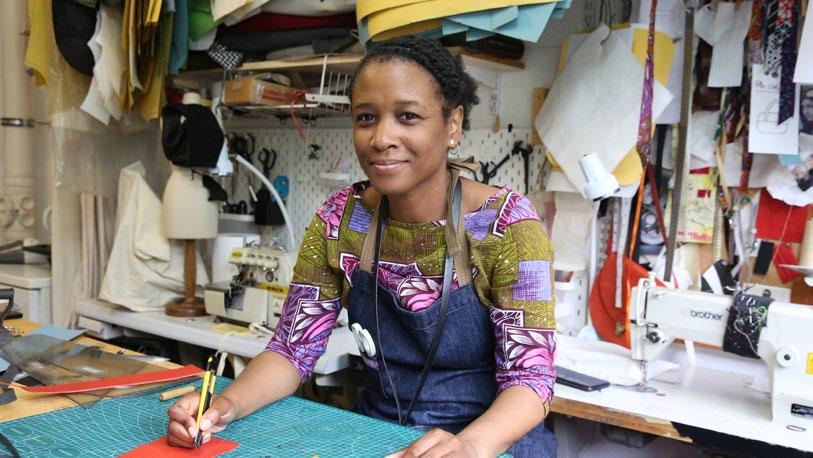
The opportunity
Work through existing networks to create opportunities for creatives to collaborate and strengthen connections, for example through production of events and festivals.
The impact
Through working together, creative professionals build lasting connections, that create future opportunities.
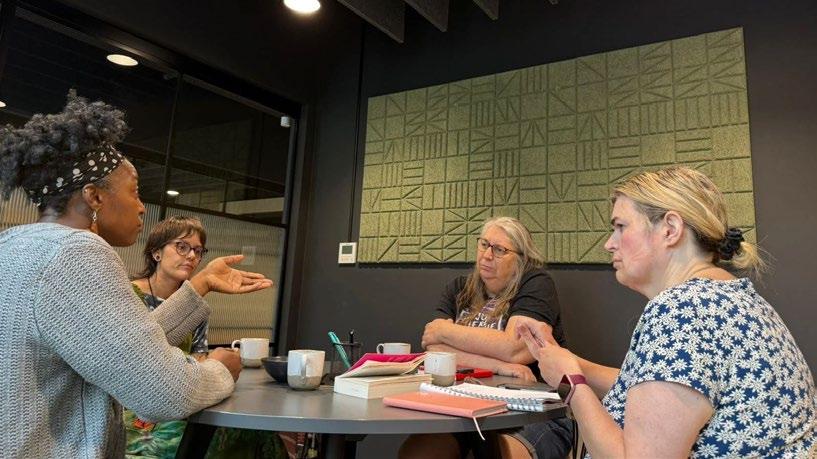
Focus support on highpotential sub-sectors
The opportunity
Support particularly Film & TV, and music, performing and visual arts, which have grown in recent years, for example through a dedicated film studio, and improved rehearsal spaces.
The impact
Key industries build on past success, and become more sustainable, attracting new productions to Essex.

The opportunity
Build further understanding of the need, to develop relevant support for workers, and make systemic changes such as local procurement requirements.
The impact
Essex becomes an attractive destination for creative freelancers, and find it easier to make a sustainable career in the county.
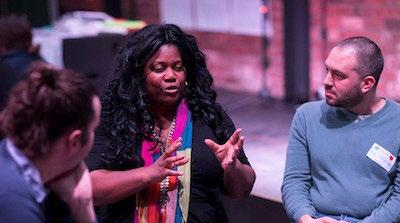
The opportunity
Work with creative and educational institutions to create practical pathways into creative careers, and support schemes for lifelong learning and creative skills development.
The impact
Young people from working class backgrounds are supported to choose creative careers, and creative professionals at any age can learn new skills and technology to enhance their practice.

The opportunity
Promote and celebrate the benefits and opportunities of investing and locating creative businesses in Essex, through for example a campaign, an investment prospectus, or cultural manifesto.
The impact
Investors and creatives understand ‘why Essex’, and are provided the confidence to make a career, and investments in the area.

– Secure dedicated leadership and coordination: Champion and secure ongoing strategic oversight and dedicated resource (staff/consultant) to drive roadmap implementation and interface with all partners.
– Empower and coordinate ambassadors: Provide clear direction, support, and coordination for Cultural Ambassadors to initiate and progress key early actions.
– Facilitate cross-sector collaboration: Act as the central hub, connecting partners, sharing best practices, and facilitating joint initiatives across the county.
– Appoint a Cultural Champion: Designate a named Council representative to serve as a key resource, contact, and advocate for Culture Essex and the creative industries within their locality.
– Localise and resource initiatives: Actively participate in the programme of work, help identify local creative talent and partners, and explore opportunities to leverage local resources.
– Integrate local cultural ambitions: Ensure local cultural ambitions align with and feed into the broader Essex-wide strategy, identifying opportunities for joint funding or delivery.
– Active co-creators and advocates: Play an integral role in shaping and delivering roadmap goals, leveraging their expertise, networks, and influence within Essex’s creative communities.
– Amplify and connect: Champion Essex’s creative sector, acting as vital conduits for feedback, making introductions, and inspiring participation from their peers.
– Support and mentor: Contribute skills and experience to specific actions, such as mentoring emerging talent, participating in networking events, or advising on subsector development.
– Strategic endorsement and collaboration: Publicly endorse the roadmap and actively seek opportunities to collaborate on specific actions, bringing their unique expertise and networks.
– Contribute resources and expertise: Provide tangible support through co-delivery of programmes, offering in-kind contributions (e.g., venues, equipment), financial backing, or specialist advice.
– Amplify and integrate: Help integrate creative opportunities into their own strategies and amplify the road map’s message to wider audiences.
London
+44 (0)20 7252 3400 Manchester
+44 (0)161 9743206
Creative sector definition
The widely used definition set out by DCMS includes the following sub-sectors:
Advertising and marketing
Architecture
Crafts
Design and designer fashion
Film, TV, video, radio and photography
IT, software and computer services
Publishing
Museums, galleries and libraries
Music, performing and visual arts
Geography definition
Essex and ‘Greater Essex’ are used interchangeably to refer to these 14 counties:
The 12 counties currently forming the adminstrative boundaries of Essex:
– Basildon
– Braintree
– Brentwood
– Castle Point
– Chelmsford
– Colchester
– Epping Forest
– Harlow
– Maldon
– Rochford
– Tendring
– Uttlesford
The 2 unitary counties include:
– Thurrock
– Southend
notes
Considerations in the selection of data points are as follows:
Benchmarking
Great Britain and England are both used as national benchmarks due to difference in the way key datasets are collated.
Data time periods
Publicly available data was generally collated from 2020 until the most recently published data, to capture the latest trends in a 5-year period. Data shows the impacts of the Covid-19 pandemic tend to show up in the data from 2021, meaning 2020 is a generally reliable baseline.
While we set out a robust research approach, there are some constraints and limitations which should be considered when drawing conclusions from the work.
– Creative freelancer numbers are recorded at the Census, but are not tracked annually in the Business Register and Employment Service (BRES) data alongside creative jobs, making it difficult to gain a true picture of the trends in this key part of the sector.
– The focus of this study was the creative economy in Essex, and as such the study does not directly uncover data on the many other positive impacts of the sector such as health and wellbeing, creativity, and placemaking.
This report was written and prepared by We Made That on behalf of Culture Essex. culture-essex.co.uk culture@essex.gov.uk
